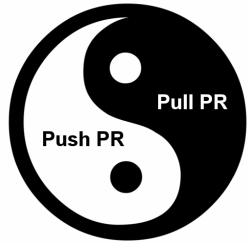
One of the key components of the presentation I gave this morning at the Las Vegas Pubcon conference presented the idea of press release optimization and social media news releases in the context of push and pull. But before that, it’s important to understand the market opportunity with news search.
According to a report released by comScore, half of all internet users visited news sites in June 2006. Of the most popular news web sites, Yahoo News is #1 surpassing CNN, MSNBC and AOL News.
There’s also an increase in the use of social media both by end consumers and the media for tracking information that interests them. This includes: blog and news search engines, social news, social bookmarks, podcasts and video. The thing that ties all of this together is RSS. RSS enables people to subscribe to the kinds of content from the channels or formats that they are interested in.
What is important to understand is that online PR is effective for direct to consumer communications as well as media relations. The bonus is that adding social media to online PR initiatives can have a multiplying effect.
Enter the notion of push and pull PR.
Push basically means the tactics used to distribute a company’s news including using press releases sent out via wire services, email or fax. It also includes pitching the media on story ideas and contributed articles.
Pull activities are based on the demand consumers have for online news as well as the search activities of people in the media looking for subject matter experts, researching past news coverage and looking for story ideas. Pull PR makes it easy for the media and your intended audience to find and pull themselves to your news.
On a continum, push and pull would be on either end with media coverage in the middle. Achieving media coverage by one or both push and pull allows you to further extend the reach of your news. First, by pulling more readers to your message via the publications that have picked up your story. Second, by using that media coverage as a direct marketing promotion via email or direct mail.
Examples of pull PR:
- News search engine visibility
- Organic search engine visibility
- Social news and bookmark sites
- Blog & RSS search engines
Examples of push PR:
- News release distribution
- Pitching journalists and bloggers with story ideas
- Social Networks/Rollodex
- Paid reviews on blogs (advertorial)
One of the most unexplored opportunities for effective push PR is blogger relations. Pitching bloggers can be a slippery slope, so keep in mind the following considerations:
- Be relevant – Mass emailed press releases do not work with bloggers. Review the blog’s categories and previous posts and only offer related news.
- Personalize – Blogging is much more a personal expression than writing articles in a mainstream publications and bloggers respond to personal messages. Generic and poorly written pitches will either be ignored or posted to the blog for everyone to see.
- Make it easy – Write a summary of your news with links to full versions and related resources. Many bloggers will copy paste your summary, add a few of their own comments and link to the news release.
- Schwag is good – If you have products or services that can be tried out, be sure to offer them.
- Be persistent – Many bloggers have day jobs and do not have a lot of time. Do not be discouraged if your news does not get picked up or if you do not get a response on your pitch. Try again and be persistent, but not annoying.
Fundamental press release optimization includes keyword research, placing keywords in the correct positions and frequency in the release and adding links. A social media release deconstructs the content offerred in a regular press release into sections that can be more easily scanned and used by journalists to glean story ideas.
The social media press release was introduced by SHIFT Communications. We don’t follow the same page layout, but include many of the same elements including:
- Headline
- Abstract or Summary
- Key points as bullet points
- Quotes
- About the company
- Logo graphic and headshots as appropriate
- Media contact information
- Link to a del.icio.us resource page
- Links to Technorati tags
- Links that enable the reader to bookmark the release
- RSS subscription links
- A link to the release in a traditional format
After the release has been distributed and pitched, here are several post-release distribution actions:
- Post news release on company site or blog enabled media room
- Bookmark the release with social bookmark services
- Bookmark pickups with del.icio.us
- reate a MS Word doc and PDF version of the release optimized with keywords and links and embed images/media
Success can be measured through:
- Wire service reporting – impressions, reads, prints, pickups
- Clipping services – online and offline pickups
- Web analytics – referring traffic and conversions as appropriate
- Google Alerts, Yahoo Alerts – Email notifications
- RSS: Technorati, Google Blog Search, BlogPulse.com
By optimizing your content and adding social media, you can increase the distribution channels and take advantage of increased visibility to demand driven traffic. A PR strategy that involves both push and pull provides many more opportunities for coverage than any single tactic.


